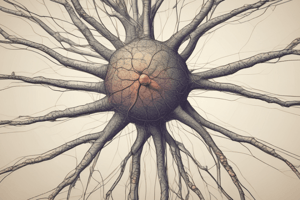Podcast
Questions and Answers
What are the three specific functions of the nervous system?
What are the three specific functions of the nervous system?
- sensory input, integration, peripheral involuntary input
- integration, sensory input, motor output (correct)
- sensory input, integration, peripheral interpretation
- motor output, peripheral interpretation, voluntary input
Which structures comprise the central nervous system (CNS)?
Which structures comprise the central nervous system (CNS)?
- brain and spinal cord (correct)
- cranial and spinal nerves
- brain and cranial nerves
- spinal cord and spinal nerves
What does the peripheral nervous system (PNS) include?
What does the peripheral nervous system (PNS) include?
- brain and cranial nerves
- brain and spinal cord
- cranial and spinal nerves (correct)
- spinal cord and spinal nerves
The afferent division of the nervous system is responsible for which type of function?
The afferent division of the nervous system is responsible for which type of function?
Which of the following correctly identifies the three basic parts of a neuron?
Which of the following correctly identifies the three basic parts of a neuron?
Which type of neuron transmits impulses from the central nervous system to muscles and glands?
Which type of neuron transmits impulses from the central nervous system to muscles and glands?
What are the gaps in between the myelin sheath called?
What are the gaps in between the myelin sheath called?
A bundle of axons in the central nervous system is referred to as a:
A bundle of axons in the central nervous system is referred to as a:
Which type of cell supports and nourishes neurons?
Which type of cell supports and nourishes neurons?
Which mechanism contributes to maintaining the resting potential of a neuron?
Which mechanism contributes to maintaining the resting potential of a neuron?
Which of the following is NOT true about the resting potential of a neuron?
Which of the following is NOT true about the resting potential of a neuron?
The process of moving sodium ions into the axon to make the inside positive is known as:
The process of moving sodium ions into the axon to make the inside positive is known as:
Which term describes the nerve signal transmission over myelinated axons?
Which term describes the nerve signal transmission over myelinated axons?
Chemical messengers that facilitate communication between neurons are called:
Chemical messengers that facilitate communication between neurons are called:
Flashcards are hidden until you start studying
Study Notes
Functions of the Nervous System
- Sensory input: Gathers information from sensory receptors about internal and external environments.
- Integration: Processes and interprets sensory inputs to form responses or decisions.
- Motor output: Transmits signals to muscles and glands for action.
Central Nervous System (CNS)
- Comprises the brain and spinal cord, responsible for processing and coordinating sensory information and motor actions.
Peripheral Nervous System (PNS)
- Consists of cranial and spinal nerves; connects the CNS to limbs and organs, facilitating communication.
Afferent Division
- Functions mainly in sensory input, relaying information from sensory receptors to the CNS for processing.
Neuron Structure
- Basic parts of a neuron: axon (transmits impulses), cell body (contains nucleus), and dendrite (receives signals).
Neuron Types
- Motor neurons: Transmit impulses from the CNS to muscles and glands.
- Sensory neurons: Carry impulses from sensory receptors to the CNS.
- Interneurons: Act as relays within the CNS, facilitating communication between sensory and motor neurons.
Neuron Components
- The nucleus of a neuron is found in the cell body, which contains genetic material.
- Nodes of Ranvier: Gaps between sections of myelin sheath on the axon, facilitating faster signal transmission.
Axon Bundles
- In the CNS, a bundle of axons is called a tract.
- In the PNS, a bundle of axons is referred to as a nerve.
Communication in Neurons
- Neurotransmitters are chemical messengers that transmit signals across synapses between neurons and other cells.
- Neuroglia cells support and nourish neurons, playing a critical role in neuronal health.
Myelin Sheath Formation
- The myelin sheath around axons in the CNS is formed by oligodendrocytes, while Schwann cells create myelin in the PNS.
Neuron Structure Classifications
- Neurons can be classified by structure, such as unipolar, bipolar, and multipolar—multipolar neurons include most motor and interneurons.
Resting Potential
- At resting potential, the neuron membrane is polarized, with the outside being positively charged and the inside negatively charged.
- Sodium ions are more concentrated outside the neuron, while potassium ions are more abundant inside.
Maintaining Resting Potential
- The active transport sodium-potassium pump helps maintain resting potential by moving sodium out and potassium into the neuron.
Action Potential Initiation
- A stimulus can initiate an action potential by opening sodium channels, allowing sodium ions to flow into the axon.
Ion Movement and Membrane Potentials
- Depolarization occurs when sodium ions enter the neuron, making the interior positive.
- Repolarization is the process of returning the neuron membrane to its resting potential after depolarization.
Nerve Signal Transmission
- Saltatory conduction refers to the jumping of action potentials between nodes of Ranvier, speeding up nerve signal transmission across myelinated axons.
Studying That Suits You
Use AI to generate personalized quizzes and flashcards to suit your learning preferences.




